Croatia's Islands: Few Coronavirus Infections Betray A Dark History
April 6, 2020 — The Bura swung then pummeled the island of Iž along its flank. “Bura de levantara,” as the elderly call it. The air was briny. The seagulls hung suspended in the sky, beaks piercing the wind.
The coronavirus yesterday claimed the life of a middle-aged, otherwise healthy man — the first such victim in Croatia. Yet on this island and many other bucolic, empty hideaways, you’d never know there was a pandemic.
The nation's islands have been spared the brunt of the COVID-19 pandemic. Infections remain low, with Murter being the lone exception.
Locals admit their feeling of safety comes with a dose of guilt... and fear that every island's inoculation against this global pandemic is mere luck. Luck which may run out.
“Ne izazivaj vraga,” they say. Don’t tempt the devil. Indeed.
Women of a certain age still say, “Kuga te ubola.”
It loosely translates to “May the plague get you.” Depending on the context, it’s either a curse against an enemy or expression of delighted shock at inappropriate humor.
It’s still in use for a reason. Because Iž and other islands like it suffered terrible losses during previous pandemics. The Bubonic plague, cholera and Spanish Flu swept through these coastal hideaways like a tsunami.
COVID-19 is the outlier — for now.
Familiar with plagues
Virtually every deadly pathogen that hit Europe also swept across Croatia's islands. Anecdotes, church records and census numbers show odd demographic oscillations so precise, they can’t be the usual harbingers of death — war and famine. Process of elimination leaves only disease.
The Bubonic plague hit Zadar 20 times between the sixth and 17th centuries, according to late historian and Iž native Dr. Roman Jelić. The plague became so common, locals built churches, chapels and altars devoted to Saint Rocco, who protected against the illness (Mali Iž’s altar among them).

The island of Lokrum served as a lazaret for Dubrovnik during the Black Death. The innovation quickly spread.
As the plague hit over and over, Zadar’s islands coopted an efficient system of stopping the spread of the illness, one recognizable today and oft-attributed to Dubrovnik. Good ideas, like plagues, often spread quickly.
Confirmed infections on islands went to lazarettos, or infirmaries, built in the hinterlands or the uninhabited islets. This early form of the quarantine and forced self-isolation set the foundations for the current fight against COVID-19.
Still, the numbers were staggering.
The island of Ugljan at the end of 17th century lost nearly 10 percent of its population in a single year. Records suggest the plague swept through the island, end-to-end, with the neighboring islands Galevac and Ošljak serving as lazarettos for the ill.
A century later, Molat lost 141 residents — more than a quarter of its population — in the four years between 1772 and 1776.
Medieval medicine at the time included some isolation measures, but hygiene and knowledge of microscopic killers were non-existent. The islanders of lore were helpless to stop the viruses. A full-time medical professional on a Dalmatian island is a modern invention, arriving about the same time as electricity.
Other deadly pathogens followed the plague: diphtheria, smallpox, scarlet fever, typhus, dysentery, and the Spanish Influenza. The lazarettos built for Black Death sufferers remained, repurposed for every new disease.
No one to infect
The modern coronavirus pandemic in Croatia began around in the beginning of March. Not that anyone on the islands noticed a difference.
The newer houses built by foreigners sat dormant — as usual. The other homes grow quiet, one by one, every time the death bell tolls.
The coronavirus’s great gift to Dalmatian islanders was its timing. It arrived during the annual stretch of ghoulish emptiness that leaves one wondering if anyone lives here at all. Had it hit two months earlier or later — New Years or the summer — and the situation would look bleaker.
The few who live here all year emerge from their homes every morning. Some split olive wood to prepare stoves for the single match that’ll heat their house at sunset. Others wait in line for a loaf of bread.
All have routines to survive early March: the temperature fluctuations and bitter wind sweeping down from the Velebit Mountain make it a torturous time. That signature March Bura. The “healthy” wind which pseudo-scientists around here claim is a panacea for many ailments.
It clears humidity out of the air, they say. Dries the sinuses, leaves a crust of salt on doors and windows. It cuts through the thickest of jackets.
Winter life will keep us safe, they say. Here, the winter sun is medicinal. (From April onwards, it’s a menace.)
Social isolation doesn’t need a mandate here either. At this time of year, it’s the norm.
If COVID-19 found its way to islands like Iž, it’d lack hosts. The regulars on the island keep a safe distance from each other — blame water-saving over hygiene, emotional suppression, and the disinterest that comes with seeing the same faces at the same time every day. Attempts at physical contact betray a too many drinks… or fair-weather friend trying to make good with the locals. We know better.
When a biting wind sweeps across your face and sends a chill to the base of your skull, a hug or a handshake feels ridiculous. Head nods and grunts are enough.
No well-wishers, family members, weekend visitors, or preparations for summer flings. Save a weekend bacchanal for carnevale, or perhaps a funeral, you’d be hard-pressed to find anyone visiting Iž or any of the other smaller islands before Easter.
Still Following Protocols
Make no mistake: people here follow the rules with aplomb. The store only allows one patron at a time, each greeted with a squirt of hand sanitizer at the door. The others wait outside in a haphazard line, with each new arrival pointing a questioning finger to see who’s ahead of them.
This rationing and pseudo-caution that comes with assuming everyone is a vector for a virus is familiar. The history of population-wide illness left a mark on many island norms.
In a long enough conversation, someone will mention a distant ancestor known to have died of… something. Those tales still circulate, along with the centuries-old quack medicine for combatting the illnesses.
Locals also used to fumigate their houses with burning juniper bushes to oust the plague. While nobody smokes themselves out of their own home, islanders still have an immeasurable fear of drafts — a well-documented phenomenon that dates back to the era when tuberculosis, common colds and pneumonia were death sentences.
It’s still customary for a visitor to shout your name a few steps before they arrive at your door — a bit of common courtesy predating doorbells but also a chance to be sent away without getting too close.
Folk medicine remedies are still common. Every bodul (islander) shoveling spoonfuls of honey into their gullet to combat a cough can thank their ancestors, who did the same to survive tuberculosis and pneumonia. Ditto to inhaling the vapors from sage or chamomile tea, a centuries-old remedy for pulmonary illnesses.
Some islanders even continue to pile on layers of clothing and blankets to treat a fever, believing it helps the body cook out the pathogen. These treatments are still being suggested to young islanders with the fervency of Gospel.
Perhaps the closest the islands saw to today’s pandemic was the cholera outbreak of 1855, which hit every settlement on every island in the Zadar archipelago. The incomplete records from the time show 7,770 people were infected, 2,690 of them died. A 34 percent mortality rate. (It should be noted Patient Zero arrived from Italy.)
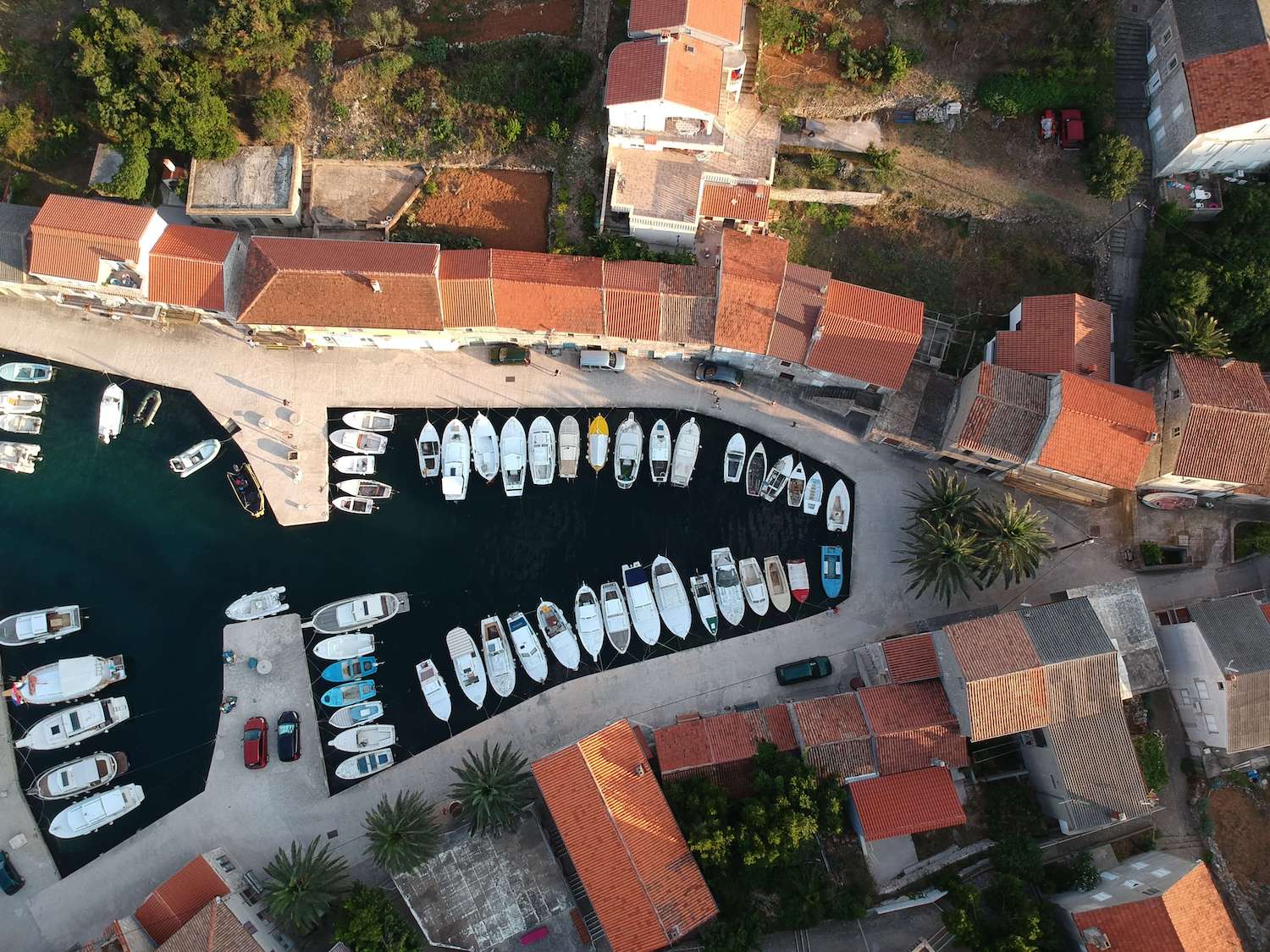
The author's home: devoid of people whether there's a pandemic or not.
Offering An Escape
During past the pandemics, those fearing death often fled to the Dalmatian islands. It may happen again.
Already detached from societal epicenters, the potential for an island becoming a pandemic hotbed disappeared over the last century, as islanders emigrated to the generous shores of Canada, Australia and the United States. Even Murter, now a hotbed, had its COVID-19 allegedly imported by tourists who wanted to get an early start on "The Season."
That's not to say the islands like Iž and others are immune to nasty pathogens and the ornery nature of life on this planet. But maybe the four-mile gap between these shores and the mainland is just enough to keep the inhabitants safe.
That sense of detachment and self-sufficiency fuels the people living here year round. But the longer this pandemic lasts, the supposed-faults of island life will slowly become appealing to The Crowd. Those who often shun a quiet existence to be at the vibrating center of modern civilized life. Their norms are now poisoned.
Isolation, solitude, peace, and detachment from the throngs, shopping centers, cultural institutions and a quiet social life... are now luxuries. And potential life-savers.
A parade of fresh faces uprooting their homes to these islands is inevitable. They’ve already made calls, promising to be here soon. They’ll join a long and storied tradition: escaping to the Dalmatian islands for refuge.
It’s something those of us with roots here all share: there is no native bodul. Everyone came here to escape from something: fights between Venetians and Ottoman Turks, famine… plagues.
This pandemic will end. The sun will continue to rise just behind the neighboring island of Ugljan and settle in the west behind the church steeple at the top of the hill. Like it always does.
Those still alive when this is all over will tell their kids and grandkids what it was like to watch fraction of the world suffer even though the illness touched nearly everyone.
And those who passed the time on Croatia’s bucolic little islands will hopefully shrug and say, “Nothing really changed for us. A few more people showed up and, when it was over, they all left.”
Don't tempt the devil.
Government Introduces e-Passes and a Little Leeway, Despite "Stay at Home"
April 1, 2020 — From dog grooming to neglected gardens, many Croatians responded to “stay at home” with a, “Yeah, but…”
The government is responding with measures meant to streamline the system of “passes” designed to track movement, while also increasing the number of exceptions to the “stay at home” mantra.
Ivan Malenica, Administration Minister, unveiled an “e-Pass” service to streamline the until-now Byzantine “pass” system which allows citizens to travel within the country. It should be available by the end of the day.
The app, within the Shared Services Center, links with the Ministry of the Interior, the Tax Administration, the Croatian Pension Insurance Institute (HZMO), the health system and the Civil Protection Headquarters.
“It's not about the app, it's about the shared services center,” Malenica told N1. “The e-pass system is intended for citizens under the civil protection system and, if necessary, towards employers.”
The e-Pass system creates a single point to access and monitor issued passes, said Malenica. Citizens can access passes through Croatia’s “e-Citizen” system, an online repository of government services and information available to anyone with an official identification card.
Citizens granted a pass can print them out or keep them on their mobile device. Each pass features a QR code which police officers can scan.
Previously issued passes will be accessible through the system.
“The goal is to speed up and digitize the whole process,” he said.
Those who do not have access to the “e-Citizen” service can use the current means of request via email and doctors. Employers, doctors and the Civil Protection Directorate can still give out passes.
The passes were introduced after the March 22 earthquake hit Zagreb. The government banned citizens from moving within the country, demanding they remain in their declared legal residence.
Closing loopholes
The previous system of giving out passes created many lapses, and was proving hard to maintain.
Over 50 residents of Brodsko Posavske County tried to leave the area after the measures were introduced, Mijo Kršić of the county’s police department told Jutranji List.
The requests for passes started trickling in — some justified, others silly.
“Individuals were asking us to issue passes to go get their dog groomed,” said county leader Danijel Marušić. “There were other similar requests that are not necessary and not relevant at the moment.”
This system plans to close such loopholes by overlapping various information at the national and local level, while also giving the Civil Protection Directorate a better handle on movement.
“There was abuse of the whole system because employers were able to issue passes to non-employed persons,” Malenica said, adding that the goal was to digitize and make it easier for citizens and employers to get passes, according to Dnevnik.hr.
Loosening restrictions on islands
The Civil Protection Directorate’s “stay in place” orders scuttled plans to spend the pandemic in weekend homes well away from urban centers, in less-inhabited coastal towns and islands.
The government has, for now, loosened up those restrictions slightly, allowing local agencies to decide the urgency and necessity for someone to go to an island.
Some local authorities have already promised to pull back restraints on visiting islands. Zadar, for example, will now allow citizens to visit islands if they own agricultural land in need of attention — regardless of whether or not they reside there. The measure is not limited to companies or family agricultural businesses, but private citizens with agricultural land — pending confirmation they have land to tend.
Business owners and their workers must also show an urgent need to go to an island to get a pass to islands or remote areas.
One group not getting passes: those ordered into self-isolation.
600 Million Kuna for 33 High Quality Projects of Island Associations
Croatian islands are full of events, traditions and cultural manifestations. Many of them are highly individual to either a particular island or a particular town on the island. Croatia's many islands also boast island associations, and they are as numerous and as diverse as the rich history and culture of the gorgeous islands they represent.
From the very north to the south of the country, the Croatian coastline is dotted with 1000 islands, some of which are inhabited and boast excellent connections to the mainland, and some of which are just as they were hundreds of years ago, wild, uninhabited and completely free of human interference.
These islands are some of Croatia's most priceless possessions, and the island associations which call them home have been on the receiving end of generous cash sums from the state budget.
As Morski writes on the 19th of December, 2019, the Ministry of Regional Development and European Union Funds has awarded a total of 600,000.00 kuna to 33 of the highest quality projects organised by various island associations, and as many as fifteen of them are islands from Croatia's southernmost county - Dubrovnik-Neretva County.
Following the appropriate call for the project, which then grants substantial financial support to Croatian islands using money directly from the state budget of the Republic of Croatia for 2019, the Ministry of Regional Development and European Union Funds has allocated the large, aforementioned sum of cash to various island associations for their respective projects, which have, as such, been deemed to be of high quality.
As stated, almost half of the projects and the total amount, ie, fifteen projects in the total amount of 282,500.00 kuna has gone to islands located in the extreme south of Croatia, more precisely down in Dubrovnik-Neretva County.
Among the island associations that have received grants are two from the Pelješac peninsula, three from the island of Lastovo, and ten from the island of Korčula.
Make sure to follow our dedicated lifestyle page for much more.
European Union Affirms Energy Transition of Croatian Islands
As Morski writes on the 7th of June, 2019, the European Commission (EC) has recognised the value of the energy transition of European islands in 2019, in line with the Clean Energy for the EU islands initiative, the foundation of which can be credited to Croatian MEP, Tonino Picula.
The relevant text from the European Commission states quite specifically that there is a great potential for investing in wind and solar energy and energy from renewable sources for heating and cooling. Promoting such investments could increase the energy self-sustainability of Croatian islands, in line with the Clean Energy Initiative for the European Union's islands.
''I was very pleased to receive the news of additional affirmation and support for the European island transition policy, which was announced today by the European Commission. It's a confirmation that there is room for completely new initiatives and programs for raising the quality of life of EU citizens,'' said Tonino Picula, who will begin his third term in the European Parliament at the beginning of July this year.
He stressed that such clear support to the program, as has been strongly expressed by the European Commission, would be an additional argument to see an increase the European Comission Secretariat's budget to more than one hundred million euros during the next budget period.
Among the list of items in the European Commission's focus are investment policy on research and innovation, sustainable urban and rail transport, energy efficiency, renewable energy sources and environmental infrastructure, all of which are clearly highlighted, taking into account regional differences and increasing the capacity of the competent bodies to realise and implement public projects and policies, which Picula has often emphasised in all of his recent criticisms of the current capacity of Croatian institutions to properly carry out this demanding job.
Picula, along with his colleagues in the European Parliament, initiated the need for the adoption of a resolution on the special situation of the islands, which the European Parliament quickly recognised as the need to adopt special policies relating to islanders and their lives, given that they are often greatly different to that of people living on the mainland.
To briefly recall, as many as ten Croatian islands, out of a total of fifty of the country's inhabited islands, are participating in energy transition pilot projects, which makes Croatia the most successful member of the EU in this competition.
Cres, Ilovik, Lošinj, Male Srakane, Susak, Unije, Velike Srakane and Brač, Hvar and Korčula have been enabled to prepare for the use of renewable energy sources, which will help these islands to better preserve the environment and raise the quality of life of their inhabitants.
Follow our dedicated lifestyle and politics pages for much more.
UNESCO Heritage of Croatia - Vis Archipelago UNESCO Global Geopark Croatia
May the 27th, 2019 - taking a closer look at beautiful Vis and its UNESCO heritage.
On the 17th of April, 2019, the UNESCO Executive Board approved the designation of eight new Global Geoparks which demonstrate the diversity of the planet’s geology. Croatia's Vis archipelago got this recognition. This article will take a closer look into some natural heritage from the stunning Vis archipelago.
The Vis archipelago covers the island Vis and the surrounding islands and islets Biševo, Sveti Andrija, Brusnik, Jabuka, and Palagruža. The archipelago is the area that has the oldest and youngest geological formations.
Some parts of the archipelago are made from volcanic rocks while most of the Adriatic islands are made from sedimentary rocks. Sailors and fishermen were always aware of this specific geological area. They knew when they would sail close to volcanic islets of Jabuka and Brusnik as their compass would divert from the north, potentially putting them in danger. Vis island has parts where the foundation is volcanic rock, which created several water springs. These springs created fertile conditions, so it's no wonder the ancient Greeks chose Vis about 2,400 years ago as the place to found their first colony on the Adriatic.
The Vis archipelago is located off the coast of Croatia, and there some of the oldest rocks in the Adriatic sea, formed 220 million years ago, can be found. Sedimentary rocks are the base for most of the Vis archipelago. The origin of these rocks comes from the lithification process of sand, mud, and sea organisms.
The north-eastern region of the archipelago includes large sand deposits formed in the Ice Age which created unique forms and caves. Before the sudden rise of the sea level 12000 years ago, these islands were much larger and extended more than twenty miles. In this extended area called Mala Palagruža, an archaeologist discovered flint quarries that served for the production of early tolls believed to have been made by the islands' first inhabitants.
The Vis archipelago is formed around Vis island and includes a number of nearby uninhabited islets: Ravnik, Budihovac, Veli Paržanj, Mali Paržanj, Greben, Host, Veli Barjak and Mali Barjak and the open sea islands among which the most remote are the island of Palagruža, inhabited only by lighthouse keepers, and the magmatic island of Jabuka, some 30 nautical miles west of Vis. The surface of this maritime area covers almost 6000km2 and also includes Sveti Andrija, Brusnik and the island of Biševo which, is the only inhabited island.
In this area, the largest number of ''monuments of nature'' in Europe can be found – Blue Cave, Monk Seal Cave, the volcanic islets of Jabuka and Brusnik, Stiniva Cove, and the Green Cave on the islet of Ravnik.
The Vis archipelago is a small area, but it boasts a wide range of significant landscapes and protected monuments of nature, some of which attract a lot of visitors.
The Blue Cave
In 1884, the Viennese painter baron Ugen Ransonnet introduced the Blue Cave on the island of Biševo to the world. His discovery marked the beginning of tourism in Dalmatia, and the Blue Cave has since become a must-see tourist spot in the Adriatic. The Blue Cave has been a protected geomorphological monument of nature since 1951. Visitors can go to the cave from Biševo Mezoporat. There are people all over the world visiting this unique cave every summer.
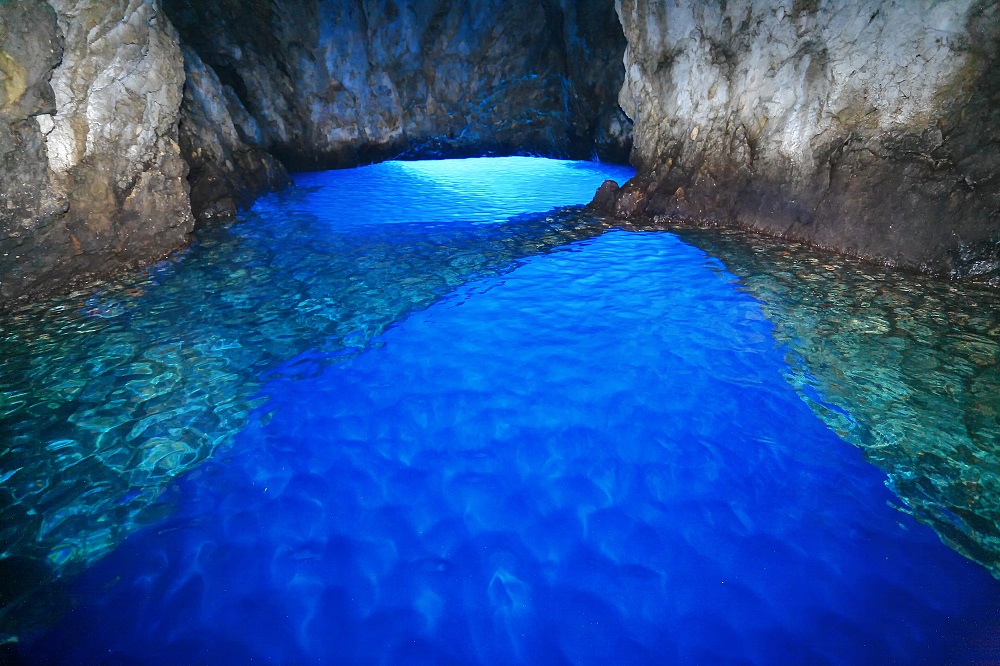
The Monk Seal Cave
The Monk Seal Cave is the longest sea cave in the Adriatic – 160 metres. It is a protected geomorphological monument of nature from 1967. The name comes from the Mediterranean monk seal which once lived here.
Jabuka islet
Rising above the sea like a black pyramid, the island is 30 nautical miles from Komiža, is 97 metres high, and is a protected geomorphological monument of nature from 1958. The island is composed of deep crust magmatic rocks, the magnetite of which interferes with seafarers’ compasses making navigation in conditions of poor visibility extremely difficult when near it. The underwater area is rich in fish and crabs, which is why fishermen from Komiža go to Jabuka in winter and risk their lives going to the island, which has no docks.
Jabuka doesn’t have a natural bay and doesn’t provide shelter from the wind. Anchoring a boat is a difficult task due to the deep sea around the island, and its smooth rocks polished by the sea make it impossible to tie the ship around them. There are as many as twenty toponyms here, and these are the only human traces on this further insular frontier of the eastern Adriatic. The island is made from volcanic diabase rocks and is home to the endemic black karst lizard and two endemic plants.
The Green Cave on the islet of Ravnik
This cave is a protected geomorphological monument of nature from 1967, and the islet itself is a significant landscape. The Green Cave has two large openings to it and it doesn’t give the same type of blue light effect as the Blue Cave, but it's entirely unique because it has a small opening in the middle from where sunlight breaks into the cave and lights up the sea bottom like a spotlight in the darkness. The blackness of this cave enhances the intensity of this miraculous spotlight.

Stiniva bay
Stiniva bay has been classed as a significant landscape since 1967. This narrow and long bay ends with a stone ''gate'' leading into a small cove with a pebble beach surrounded by layered rock walls. Once, Stiniva was a karst cave and it probably collapsed several thousand years ago. In 2016, Stiniva was named the most beautiful beach in Europe.
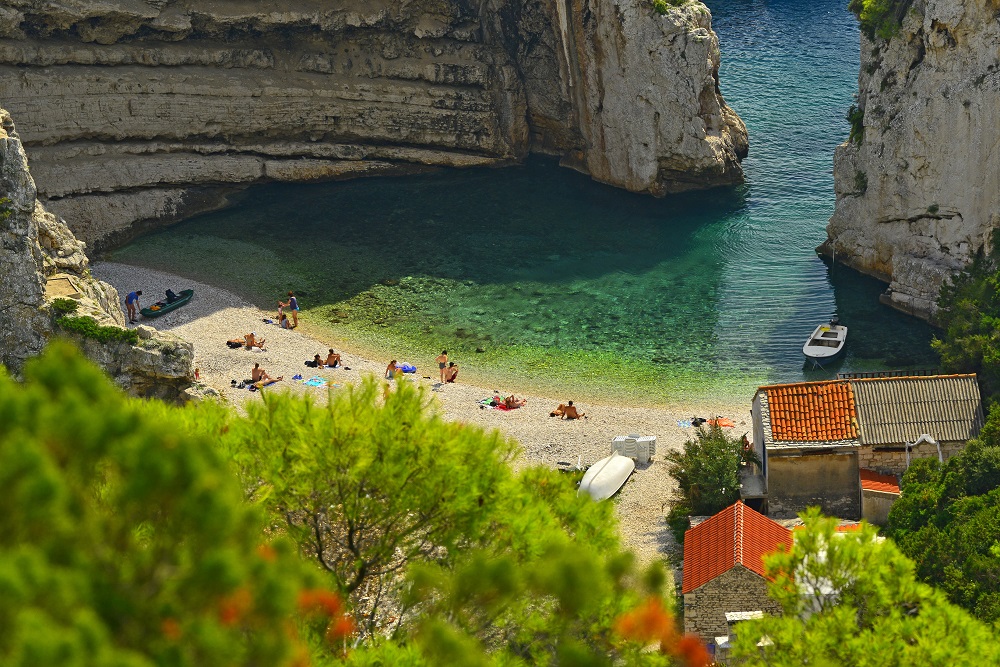
Ravnik islet
Ravnik islet is a significant landscape of nature and is located off the eastern coast of Vis, boasting its green cave.
Brusnik
Brusnik is the protected geomorphological monument of nature and is located thirteen nautical miles from Komiža. Brusnik and Jabuka are the only islands in the Adriatic formed from igneous rocks. It is 23 meters high, and both Brusnik and Jabuka are made of subvolcanic diabase formed by the crystallisation of magma on its way from the deep magmatic core up to the surface. Brusnik island is far more complex than Jabuka, however. Brusnik has paleo beach pebble conglomerates which can be found on the top of the island.
In the middle of the island, there is a ravine with a depression filled with seawater used by fishermen from Komiža, in which they made larger pools to keep their captured lobsters. There are also the remains of fishermens' cottages built from large rocks. These small homes were in use for salting fish in barrels and to keep the fishermen safe from the wind and sun. Brusnik has been a protected area since 1951 and it boasts a special structure – as most of the islands have a limestone base.
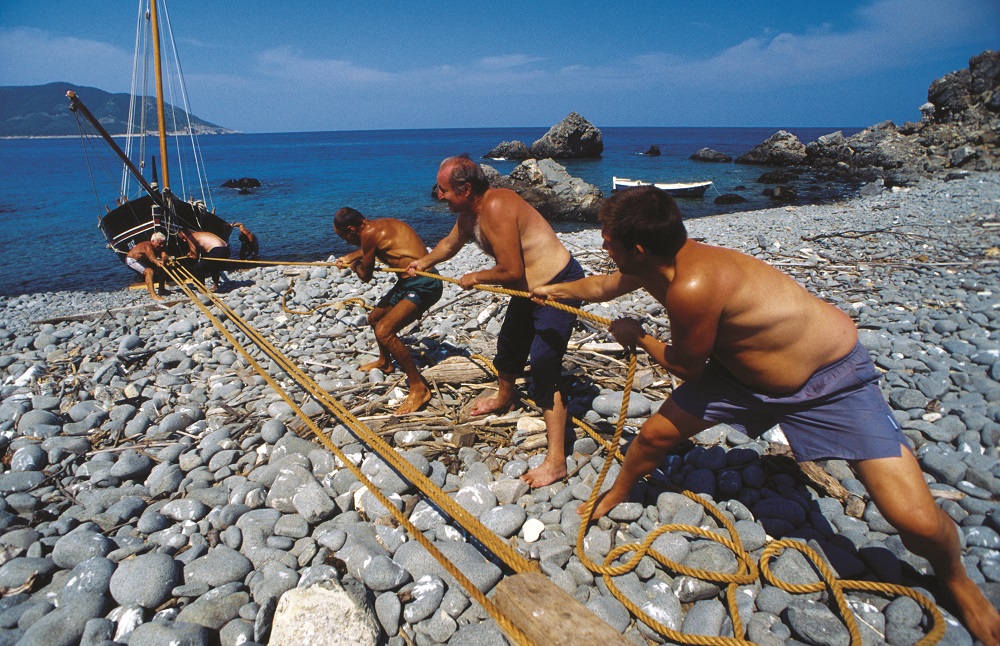
There are several geo-trails in Vis archipelago, here are a few handy links to them:
Geo trail Komiža: https://geopark-vis.com/en/geology/geo-trails
Geo trail Biševo: https://geopark-vis.com/en/geo-trail-bisevo
Geo trail Vis Rukavac: https://geopark-vis.com/en/geostaza-vis-rukavac
A list of geological locations can be found here: https://geopark-vis.com/en/geostaza-vis-rukavac
With this geological area, there are naturally a lot of local traditions and pieces of heritage worth knowing about. Some of the most valuable are Gajeta Falkuša, Suhozid – dry stone walling (another piece of Croatia's intangible UNESCO heritage), The local Vis dialect, Gajeta Falkuša, which is a traditional historical fishing boat. Fishing has been the traditional main occupation of local men from Komiža for centuries. Komiža fishermen are well known as the first to catch fish on the open sea and to face a lot of dangers due to poor weather conditions and pirate attacks.
Local inhabitants lived off the sea and were facing different threats. To fight the open sea and the risks that faced them, fishermen needed to have small and quick boats which could carry a lot in them too. To survive these rough conditions, they made falkuša – a unique traditional fishing boat from Komiža. It is made for fishing, sailing and cargo carrying. The name comes from the word falka, or the sideboards of the ship which enabled the boat to be used for different purposes.
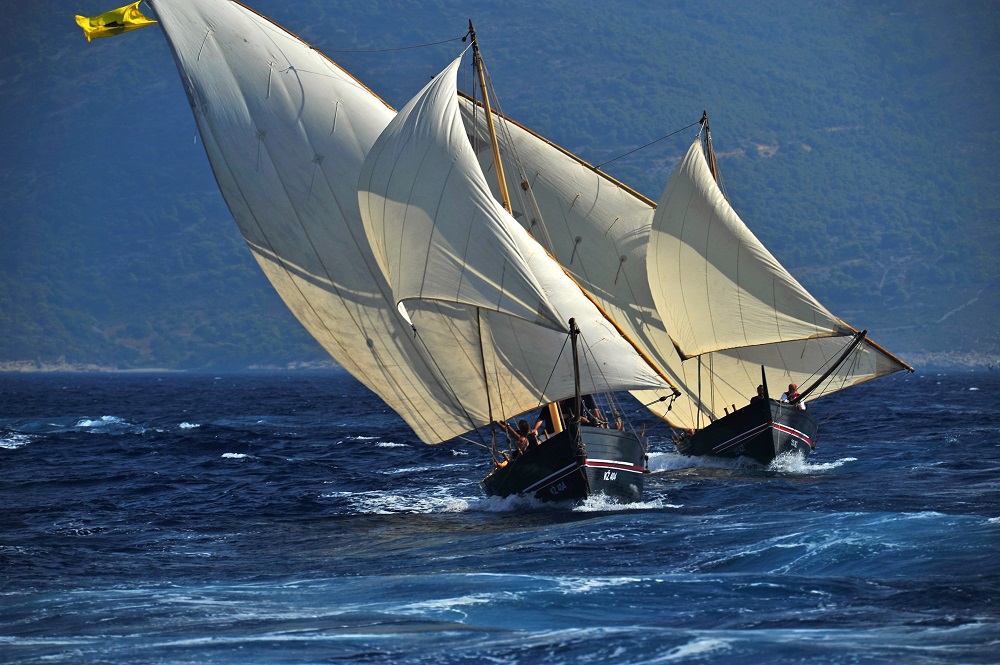
The people of Komiža are proud of Gajeta Falkuša, but it almost disappeared as the storm on Biševo island wrecked the last Gajeta Falkuša named Cicibela.
This terrible damage was repaired by professor Joško Božanić and Velmir Salamon who carried out research on Falkuša for eleven years and all of the aspects essential for this boat, including halieutic, cultural and anthropological interpretation, which included language, lexicon, literature, fishing history, toponymy and anthroponymy, shipbuilding, the art of sailing, traditional weather forecasting, the art of fishing, and even gastronomy.
In 1997 this traditional boat was saved in the form of ''Comeza-Lisboa'', the first falkuša built after many years, as part of the research project of the Cultural Association Ars Halieutica from Komiža. ''Comeza- Lisboa'' was presented at the world expo in Lisbon, Portugal. This launching was a historical moment for Komiža, where old fishing traditions, knowledge and skills were revitalised and presented to locals. Today we have four Gajeta Falkuša boats: Comeza-Lisboa, Mikula, Palagruža and Molo.
Molo is a smaller variant of Falkuša on which children used to learn fishing skills.
Dry stone walling
This piece of UNESCO heritage is an art of its own and is an old tradition which continues to be nurtured on numerous islands and in coastal Croatia, but it's especially interesting on the island of Vis. This type of rural architecture is part of the Vis landscape and has a different form than the rest. The story of dry stone walling is a story about survival, where peasants used their skills in rocky landscapes and securing smaller fertile areas to grow their vineyards and deal with other types of agriculture.
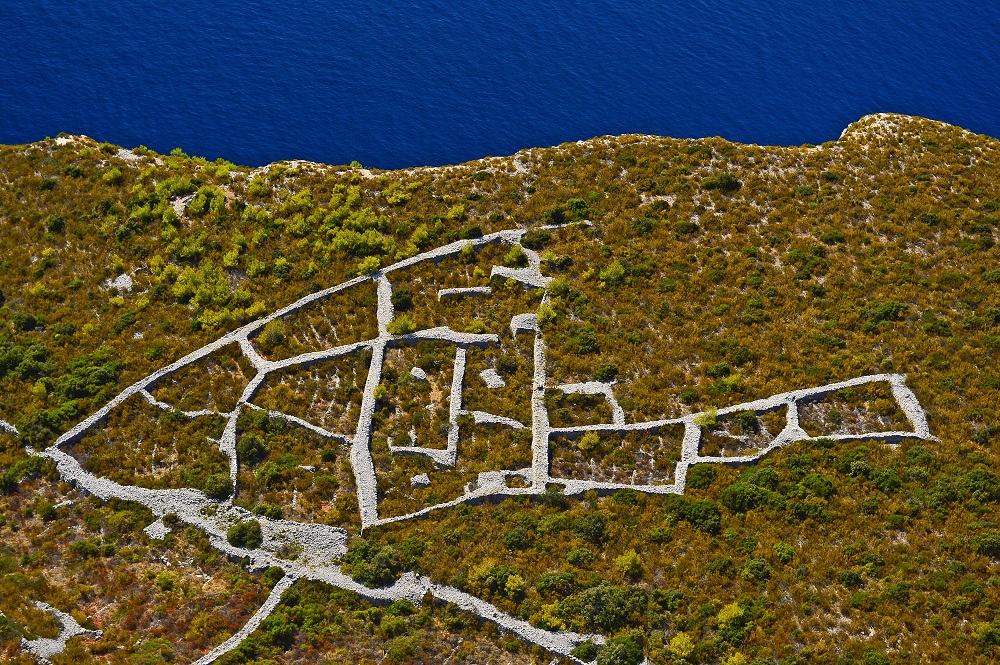
On Vis, the village of Dragodid near Komiža is very well known for its dry stone walling heritage and remains a place for dry stone workshops to this very day.
.jpg)
The Cokavian dialect of Vis
This is another piece of intangible heritage of Croatia and the oldest Slavic dialect in the Eastern Adriatic. It is unique in the fact that it preserves the lexicon from the lingua franca idiom, which is characteristic for the maritime and fishing world. Here is an example of the traditional cokavian dialect of Vis:
U śpȍmen nȍni Juvãni
Śvãku jȕtro
cîn bi źorâ źarudȉla
cîn bi źvȍna źaźvonȉla
ol śnâ bi śe vãrgla
pôk bi źavōpȉla
Ôva Marȉja
śvãki dôn źa pūlnê
kal bi śûnca grûźd śaźrîl
a iź kanpanȅla śe źvûn jōvîl
ol śtolâ bi śe dvȉgla
pôk bi źlãmen
krīźâ ucinȉla
Ôva Marȉja
ondâ jȍpet u śutûn
źajȅcol bi źvûn
a nâ bi pośôl dofinȉla
pôk bi śȅla u kantûn
krȕnicu molȉla
glōvûn obandovãla
kriźȉć buśivãla
i źãrno po źãrno
prȉko pãrśta voltovãla
Ôva Marȉja
i ȍto tãko je nȍna
iś Gūśpûn cavarjãla
trî pūtâ nã don
na plãc źvȍna
molȉtve olpivãla
i da śe nî śvȁ
u molȉtvu pritumbãla
do glũhe źemjê
da nî prĩgla śȉju
śigûr śon
jȍś bi vãvik
naźdrovjãla
Ôvu Marȉju
- Vinko Kalinić (From the collection of songs)
SOURCE(S) (text and photos): UNESCO, Geopark Vis
Find out more about Croatia's incredible UNESCO heritage by following our dedicated lifestyle page.
Go to Visovac Island for Free Between 09:30 and 10:45 on Sundays!
As Poslovni Dnevnik writes on the 23rd of May, 2019, enjoying nature and the peace of the beautiful little island of Visovac is the main motive of the visitors who come here to get away from the hustle and bustle of daily life and to be filled with new energy. The peaceful draw of this island on Visovac Lake, between the Roški slap and the Skradinski buk, is something special indeed.
When it comes to the question of just why this unassuming little pearl of the Krka National Park has always been a place for prayer and reflection, or simply a place to take in the vibrant nature, it's best to seek the answer yourself.
Visovac was first settled by the hermits, more specifically deserters of the Order of St. Augustine, who built a smaller monastery and a small church dedicated to St. The apostle Paul on the island, the Franciscans then arrived on the island after their departure.
Since the mid-fifteenth century, the Franciscan monastery and the Church of Our Lady of Visovac have been located there, which together with the natural landscape itself, make for a truly unique little island. The monastery boasts a valuable archaeological collection, as well as a varied collection of historical objects and a valuable library.
The enchanting nature of Visovac Lake and Krka National Park was quickly recognised and valued by producers, and back in the 1960s, this little island was the ideal place, what with its untouched beauty, to play the location at which the Native Americans once lived, depicted in the adventures of Winnetou. Four years ago, there was yet another new trilogy shot at Visovac.
Boats are sailing to Visovac from Stinica and Remetić.
"On Sunday, visitors to the island will enjoy free transport the boats from Stinica and Remetić, but only when the departures for masses leave (09:30/45, 10:00/15, and 10:30/45, and the boats return immediately after the end of the masses). As for the rest of the days, the boats sail to Visovac at their normal price and with the regular cruise line for Krka NP,'' writes Visovac.hr
The National Park organises excursions by boat from Skradinski buk for which its wise to set aside around two hours. A somewhat longer tour lasts for four hours, and it includes the beauty of Skradinski buk and Roški slap, as well as including Visovac. The prices are from 35 to 130 kuna per person, and children get free tickets up until four years of age, reports PunKufer.
Make sure to follow our dedicated lifestyle page for much more.
New Fast Line to Connect Croatian Islands May be Tourist Hit
The residents of Croatian islands often have rightful complaints about their connections to the mainland not being up to scratch in many cases, and while efforts are being made to create better, more reliable and more frequent connections between Croatia's many inhabited islands and the mainland, many remain less than satisfied.
As Poslovni Dnevnik writes on the 22nd of May, 2019, the carrier of this idea and the launcher of the line itself is the company GV Line Iadera from the Dalmatian city of Zadar which has many years of experience in navigation on important state routes under its belt.
Every single day as of June the 15th to September the 15th, there will be a fast passenger line on the Rijeka-Zadar route and this will also connect the islands of Krk, Rab, and Pag. This is otherwise the first and the quickest fast passenger line to connect Zadar and Rijeka and the islands in this manner, as 24sata reports.
This new line will certainly contribute to not only the ease of the lives of the residents of the aforementioned islands, but also to the overall enrichment of the tourist offer of both Dalmatia and Kvarner respectively, as well as to the better linking of the islands, since the islands of Krk, Rab and Pag have never been connected in such a way with each other, nor have they ever been connected in this way to the Croatian mainland.
Make sure to follow our dedicated travel and lifestyle pages for much more.
New Fast Connection from Split Airport to Bol Starting on 1 June
Something new is on the cards for the very beginning of next month in time for the height of the tourist season for those wanting a direct line from Split Airport to Bol on the nearby island of Brač, the third largest island in Croatia.
As Morski writes on the 17th of May, 2019, as of the 1st of June 2019 to the 15th of September 2019, the new fast-freight company Adriatic Fast Ferries d.o.o. will introduce a fast-freight line four times a day from Split Airport to Bol on the central Dalmatian island of Brač. There will be two direct connections and two lines which will head to Bol via Split's busy ferry port.
The direct connection will take one hour from Split Airport to Bol, and the line which will stop at Split's ferry port will take an hour and twenty minutes. There will be three lines in place from Bol to Split per day, according to a report from the local portal Bol info.
Unlike for other ferries and connections, tickets for this new line can only be purchased online at the ship's website.
The catamaran for this line was built back in 1999 at the FBM Marine Ltd shipyard and was purchased from the English company Red Jet. The catamaran is 33 metres long and has a capacity of 190 passengers.
Make sure to follow our dedicated lifestyle and travel pages for much more.
First Croatian Avocado Plantation Planted on Island of Vis!
As Morski writes on the 2nd of May, 2019, the very first Croatian avocado plantation has been planted on the Dalmatian island of Vis. The pear-shaped fruit can typically be found growing in Central and South America, it's very rich in vitamins, minerals and other nutrients essential for the health of the organism.
It seems that the warm Mediterranean climate bodes well for the growth of avocados because those growing are advancing well and generally give generous yields. To make the story of the very first Croatian avocado plantation even more unusual, it was kickstarted by two Americans from Wisconsin, the Repanich couple, who, despite their advanced years, have some great business plans under their belts. Perhaps because they eat avocados each and every day.
John and Patricia Repanich, a lively couple in their eighties, replaced life in America with the birthplace of John's grandfather. Back when they lived in the US, they had nut plantations in California, as well as flocks of sheep, and when retirement age came around, out of all of the places in the world, they chose no less than the beautiful island of Vis as their new home, as was reported by HRT. For years and years before that, they'd already spent plenty of time enjoying Vis's stunning Brgujac bay.
''Once a farmer, always a farmer,'' says John. Pensions aren't for rest, it's best to keep your hands busy. Their avocado experiment was fruitful. Ten years ago, they planted their first tree.
When that very first plant ended up ''giving birth'' to hundreds of the avocados, the entrepreneurial American spirit was awakened in Repanich. From Sicily, the couple brought 150 plants to the Croatian island of Vis and started the very first avocado plantation in the whole of Croatia, the first fruit of which is due this autumn.
Avocados otherwise originate from the South and North American rainforests, where, at least according to numerous archaeological discoveries, they were eaten 8,000 years ago. The first avocados were utilised by the Inkas, the Olmecs and Maya peoples, who considered it a magical plant that nourishes the body from the outside and from the inside. It is very rich in good fats, vitamins, minerals, and other nutrients essential to the health of the body.
Among other things, it benefits the heart, reduces blood sugar, helps with arthritis, and even helps people to lose weight. Experts think it is the top food for brain health because of its high share of omega-3 acids and vitamin E.
Avocados are diverse and can be eaten raw or be thermally processed in many ways, and perhaps the most famous avocado dish of all is Mexican guacamole. Thanks to Repanich's, the first Croatian avocados have become an attraction, so more and more people have been coming to Brgujac to see the premier Croatian plantation for themselves. Along with its olive oil and its wine, the island of Vis could easily also become a Croatian island known for its tropical fruits.
Make sure to stay up to date by following our dedicated lifestyle page for much more.
Pag Salt Gains EU Protection - Croatia Now Has 22 Protected Products
As Morski writes on the 11th of April, 2019, Pag salt (Paška sol) has received protection at the EU level. This information has now been published officially and Pag salt has been entered into the register of Protected Geographical Indications (EU PGI), and Pag salt has earned its sought-after protection status throughout the European Union.
"Pag salt'' is sea salt obtained directly from the seawater of Pag bay, its shape that of small cubic crystal structures that are white in colour and contain minerals and trace elements. Most of the crystals are up to 1 mm in size, so 98 percent of all of the salt crystals manage to pass through a sieve with a mesh size of 1.3 mm. It has a concentrated salty taste without any bitterness.
The seawater from the bay of Pag is extremely clean and well-filtered because the bottom of Pag bay, from which it is obtained, is highly rich in shells which act as natural purifiers of the sea, meaning the seawater in that area has very low values of heavy metals, which are at considerably lower levels than the average value of rest of the Mediterranean sea. In addition to that, Pag bay is located far from any areas in which industrial works are carried out, meaning that the sea is even more pure.
Croatia boasts a long and very rich tradition of production and preparation of various agricultural and food products that are characterised by certain special, unique qualities and traditional production methods, and now finally Pag's much loved salt has earned its protection at the highest level.
Although the Republic of Croatia is still the youngest member state of the European Union, it can be extremely proud of itself as it now has 22 different agricultural and food products with names that are now protected at the European Union level, either in the sense of having a protected destination of origin, or having a protected geographical indication. The EU currently has three such schemes which work to protect the names of quality agricultural products and foodstuffs.
Make sure to follow our dedicated lifestyle page for much more.

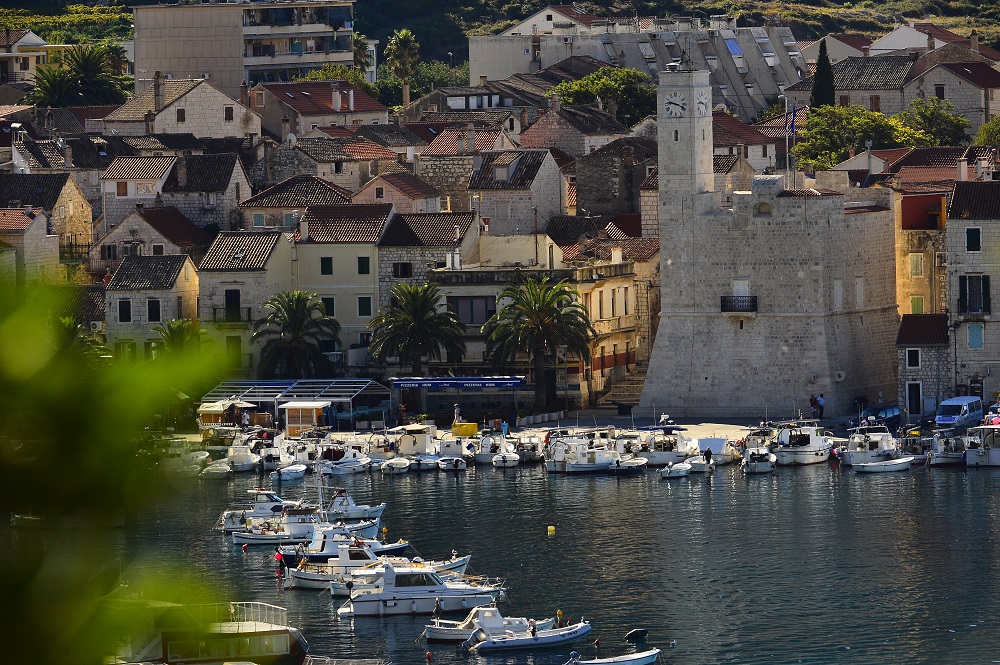


.JPG)
